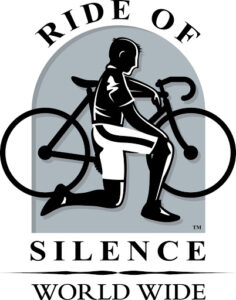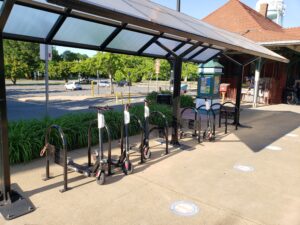
Category: City of Manassas (Page 2 of 2)
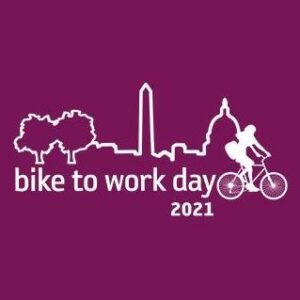
Bike-to-Work Day (BTWD) Metro DC is traditionally held on the third Friday in May. For the past 20 years, the event has been organized and promoted annually throughout the metropolitan Washington DC region by the Washington Area Bicyclist Association and the Metropolitan Washington Council of Governments’ (MWCOG) Commuter Connections program.
The event celebrates bicycling as a viable commuting mode and encourages all commuters to try bicycling for all–or for just one segment–of their work commute trip . Teleworkers are also welcome to participate, by bicycling to one of the roughly 90 BTWD rally locations (known as ‘pit stops’) throughout the Washington region and then bicycling home for their workday.
As most people know, bicycling is healthy, clean, economical, and fun. Bicycle commuting is energy efficient, reduces traffic and parking congestion, improves air quality, increases employee morale and productivity, and can lower employer healthcare costs.
Register for Bike-to-Work Day now, so you don’t miss out on the fun (and BTWD swag).
Bike to Work Day was canceled in 2020 due to COVID-19 concerns, but it ‘s back this year, with some COVID precautions in place at each BTWD pit stop.
This year, seven Bike-to-Work Day pit stops will be held throughout the Prince William area. At these locations, participants can pick up a BTWD t-shirt, water bottle, and snacks. Participants should register online in advance and show up at their selected pit stop at their scheduled check-in time with a mask on and maintain social distancing.

Click on the links below to learn the exact locations, hours of operation, and contacts for the seven Prince William area pit stops.
- Dumfries at Town Hall Community Center
- Haymarket Bicycles
- Manassas – George Mason University
- Manassas – VRE Station
- Rippon Landing VRE Station
- Woodbridge – Chinn Center (morning & afternoon)
- Woodbridge – VRE Station
Bike-to-Work Day proclamations have been issued this year by the National Capital Region Transportation Planning Board, by the Prince William Board of County Supervisors, and by the Manassas City Council.
In the United States, the League of American Bicyclists established National Bike Week (now National Bike Month) in 1956, emulating an event begun in the United Kingdom in 1923. The Washington Area Bicyclist Association organized DC-based Bike-to-Work Day events on Earth Day (April 22) for several decades until MWCOG’s Commuter Connections program adopted BTWD Metro DC as a region-wide event.
Ride of Silence – Manassas City
May 19 @ 7:00 pm – 8:30 pm
Free

During May 2021, the City of Manassas held three virtual public meetings on various transportation projects:
1) Tuesday, May 18 @ 7 pm–virtual public meeting on the Sudley Road Third Lane project . View the project design presentation on the Sudley Road Third Lane Project from the May 18 meeting.
2) Thursday, May 20 @ 7pm–virtual public meeting on four sidepath projects (Godwin Dr, Dumfries Rd, Gateway Blvd, and Wellington Rd trail gap) and three sidewalk projects (Portner Ave, Quarry St, and Gateway Blvd). View the meeting presentation and a 31-minute recording of the Zoom meeting.
3) Tuesday, May 25 @ 7pm–virtual public meeting on the Dean Drive Extension Project. View the project design presentation on the Dean Drive Extension Project.
March 15, 2021 Update: We have been informed by the City’s Director of Public Works that many of the bollards shown below have been removed. The City is now installing a single rigid bollard on the trail centerline, with additional bollards placed six feet apart at some locations. In addition, reflective tape will be installed near the top and the bottom of each bollard. While these changes significantly reduce the severity of the trail-bollard hazard, the users of these paths will still remain at some risk for serious and permanently debilitating and even fatal injuries from crashing into the remaining bollards. We urge all public agencies to heed the AASHTO guidance and FHWA recommendation (both cited below) to end the routine use of even single rigid bollards as its default design treatment to discourage motor vehicle incursions on shared-use paths.
July 2023 Update: The City of Manassas has finally replaced the former rigid black steel bollards at both entrances to its Winters Branch Trail with white plastic flexible posts with silver reflective tape! Thank you!!!
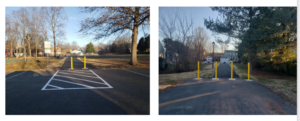
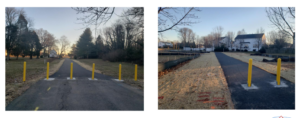
Active Prince William board member Allen Muchnick, a City of Manassas resident, sent the following notice to multiple City of Manassas officials on February 7, 2021:
I was pleased to see the lead article in the January 2021 issue of City Connection newsletter, featuring several newly built asphalt shared-use paths around Manassas. I commend City staff for working inter-departmentally to quickly fund, design, and build these valuable neighborhood connections.
However, my initial joy over these new connections was soon marred by disappointment and dread upon seeing the four photos of dangerous, unnecessary, and closely placed rigid trail bollards on Slides 20 and 21 of the Manassas Public Works annual report.
While intended to prevent both intentional and accidental intrusions by motor vehicles–and occasionally needed to prevent costly damage to fragile infrastructure, such as foot bridges–hard, rigid bollards installed within the traveled way of shared-use paths have been widely recognized for decades as a substantial hazard for people riding bicycles, causing many severe and permanent injuries and even deaths. An extensive bicyclist critique of trail bollards is posted here.
For that reason, nationally recognized guidance for the design and construction of shared-use paths have long cautioned against installing hard, rigid bollards on shared-use paths. A variety of simple and cost-effective alternative design treatments—starting with signs prohibiting entry by motor vehicles—are quite effective at preventing motor vehicle intrusions and vastly safer than trail bollards.
Although NOVA Parks’ 45-mile Washington and Old Dominion (W&OD) Trail includes scores of at-grade road crossings, NOVA Parks removed all of its former bollards and fences along that trail more than 20 years ago, in recognition of the significant danger that such obstructions pose to trail users. NOVA Parks has not seen any need to reinstall trail bollards since.
Where the risks and consequences of unwanted motor vehicle entry is significant and demonstrated, trail bollards should be installed only on the centerline of two-way shared-use paths, and flexible bollards should be used if feasible. If multiple bollards must be used, they should be used in sets of three (never two or four, to reduce head-on collisions) and spaced at least five feet apart to allow safe passage by bicycle trailers.
The Federal Highway Administration has long warned against installing bollards on recreational trails. The first bullet point states: “Even “properly” installed bollards constitute a serious and potentially fatal safety hazard to unwary trail users. In addition, no bollard layout that admits bicycles, tricycles, and bicycle trailers can exclude single-track motor vehicles such as motorcycles and mopeds. For these reasons, bollards should never be a default treatment, and should not be used unless there is a documented history of intrusion by unauthorized cars, trucks, or other unauthorized vehicles.”
Similarly, the AASHTO Guide for the Development of Bicycle Facilities (4th Edition, 2012) contains extensive guidance on trail bollards on pages 5-46 and 5-47, including these paragraphs:
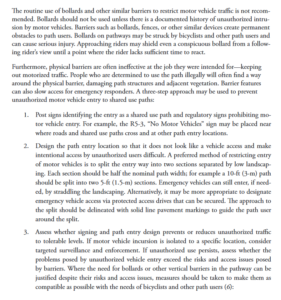
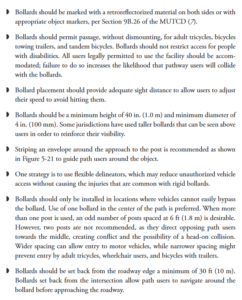
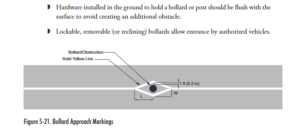
Since the above-referenced newly installed trail bollards are a well-recognized defective and unreasonably dangerous property condition for people riding bicycles, scooters, skate boards, and other devices, I ask that these trail bollards be removed immediately from the paths at Kinsley Mill Park, Tudor Lane, Oakenshaw Park, and Bartow Street and that none be installed along the still-unfinished path along the southern perimeter of the Metz Middle School property.
I’m confident the City of Manassas would never install a rigid bollard within a few feet of any vehicular travel lane, although such obstructions would mostly endanger vehicle exteriors, not human bodies. So, how can it be considered acceptable to expose non-encapsulated people traveling on balanced bicycles (or simply walking) to such dangerous obstructions?
###
